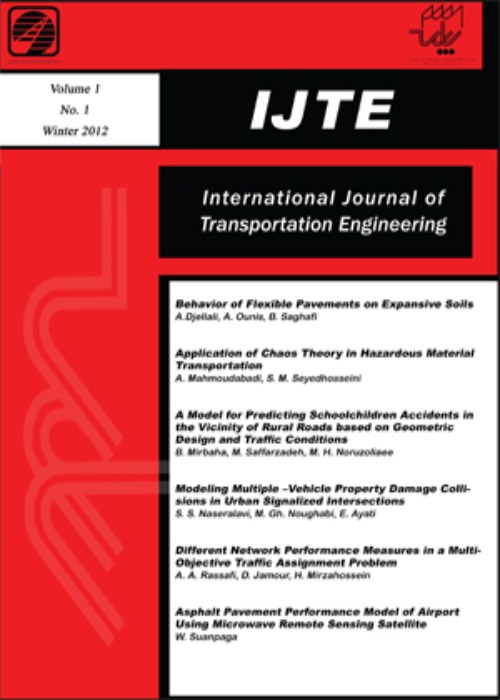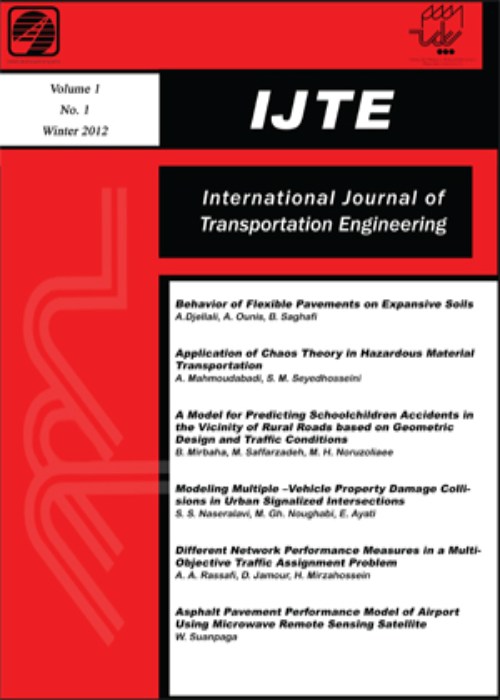فهرست مطالب

International Journal of Transportation Engineering
Volume:10 Issue: 4, Spring 2023
- تاریخ انتشار: 1402/01/12
- تعداد عناوین: 6
-
-
Pages 1163-1173In this research, factors affecting the severity of property damage only (PDO) and injury/fatal accidents were examined using taxi-related accident data from March 2015 to March 2021 in urban sites of Rasht city. The multiple logistic regression and artificial neural network (ANN) were applied to recognize the most influential variables on the severity of accidents. Results indicated that the multiple logistic regression in the backward stepwise method had a prediction accuracy of 88.54% and R2 value of 0.871. Moreover, the regression analysis revealed that the wet surface condition, night without sufficient light, rainy weather, Kia Pride taxi and lack of attentions increased the severity of accidents, respectively. The most important result of the logit model was the significant role of environmental factors, including slippery road surface, unfavorable weather as well as poor lighting condition, and also indicated the dominant role of poor quality of vehicles along with human factors in increasing the severity of accidents. Comparing the correct percentage of prediction in the multiple logistic regression and ANN model, the results showed that ANN model performed better so that the prediction accuracy of ANN was 95.8%.Keywords: safety, Urban accidents, Multiple logistic regression, Artificial Neural Network
-
Pages 1175-1192
Air traffic management (ATM) is a set of management, analytical, and operational techniques and tools, which are used to optimize the traffic flow and exploit the existing flight system capacity. However, one of the challenges in ATM use is the prevention of flight delays. Several methods such as data mining, artificial neural network evolutionary algorithm, and fuzzy logic are available in the ATM field. But the complexity level as the number of the available categories for classification increases, making it impossible to use these algorithms in air traffic management. This study is aimed to comprehensively evaluate the techniques applied in ATM and assess the tools and criteria in this context. Also, show that the artificial neural network (ANN) and long short term memory (LSTM) algorithms are most frequently used in ATM. Then a hybrid deep learning model for Mashhad airport air traffic management systems was proposed. The analysis of the system was performed using the actual data of Mashhad Airport. Our results demonstrate that among various clustering algorithms, K-means and deep learning methods are more efficient and widely used. Evaluation criteria such as accuracy rate, delay, The Root mean square error (RMSE) and mean square error (MSE) are more commonly applied in air traffic system evaluation. The implementation of the air traffic management base on hyprid deep learning could be increase accuracy of flights control operation in airports.
Keywords: Data Mining, Deep Network, Air Traffic Management, MSE, RMSE -
Pages 1193-1215
There is rising agreement that transportation systems are perfectly capable of linking economic development, environmental integrity, and social quality of life. Meanwhile a wide range of research clearly shows that transportation systems are unsustainable in most of the cities and urban areas. In practice, there are numerous transportation systems which are able to pose serious threat to the environmental, social and economic aspects of future generations. Therefore, a truly sustainable urban transportation network is definitely one of the most pressing need of cities and urban centers, particularly in developing countries. Thus identifying the evaluation criteria and determining their importance are critical. While most researches have only focused on economic or environmental aspect of transportation systems, in this paper, by considering economic, social and environmental dimensions, the evaluation criteria for evaluating the sustainability of urban transportation network have been discerned. Furthermore, a framework based on a goal programming model for Best Worst Method (BWM) has been proposed to evaluate and prioritize sustainability dimensions and evaluation criteria. In order to demonstrate the utility of the proposed model, it is employed to a real-world case study of transportation in Yazd, one of the most important cities in Iran and the first Iranian historic city. The results of this study are applied to evaluate, prioritize and select real transportation projects. Moreover, it is demonstrated how the proposed framework could assist urban managers in analyzing sustainability of existing instances, formulating effective strategies, evaluating and selecting coherent policies or even constructing projects to accomplish sustainability goals.
Keywords: Sustainability, Sustainable transportation network design, Urban Transportation, Multi Criteria Decision Making, Best Worst Method -
Pages 1217-1236This study aimed at exploring the effect of consistent design and self-explanatory the horizontal curves on crash frequency in four-lane highways using Zero-Truncated Crashes data. The present study has considered the related variables for 45 curves of four-lane intercity highways in the three-year (2018-2020). The standard Poisson distribution is a benchmark for modeling equi-dispersed count data and could not express under-dispersed Zero-Truncated data. Modeling was performed using Poisson, Negative Binomial, Zero-Truncated Poisson, Zero-Truncated Negative Binomial, and Conway-Maxwell Poisson (COM-Poisson) regression. The results revealed that the COM-Poisson regression distribution could effectively fit the model under-dispersed Zero-Truncated Crashes data. According to the results, the ratio of the curve radius to the average radius of the adjacent curves (as the alignment consistency variable), the difference between the expected and the existing superelevation (as the vehicle stability consistency variable), and the variables of the total self-explaining index and heavy vehicle percentage have significant relationships with crash frequency. As a result, increasing the self-explanatory features of curves is an efficient and prioritized policy for safety improvement on the intercity four-lane highways.Keywords: consistent design, Self-explanatory, Crash model, Intercity, Four-lane, Highway, Horizontal curve, Poisson, Conway-Maxwell
-
Pages 1237-1252
Permeable pavement, including porous asphalt, is one of the best management practices in urban stormwater control, which is an effective way to protect brick and mud from rain runoff. The aim of this study is to investigate the relation between parameters related to the surface texture of porous asphalt with evaporation and permeability as two key properties of porous asphalt. For this purpose, laboratory samples were first made. By performing permeability and evaporation measurement tests in an innovative way, the amount of permeability and evaporation of porous asphalt with different gradations was determined. Then, with image processing and English pendulum device, parameters related to the surface texture of the samples such as surface porosity, fracture of surface aggregates and slip resistance were measured. Their effect on evaporation and permeability was investigated. The results of this study indicate that with finer gradation, the amount of surface porosity and angle and visible fractures of aggregates in the sample surface is reduced by about 27% and 48%, respectively. Also, the results of slip resistance test show that in dry state, the friction decreases by about 11% as the gradation becomes larger and in the wet state, the larger the texture, the slip resistance is about 32% higher. Based on the results presented in this study, the parameters related to the surface texture of the sample have a significant relationship with the rate of evaporation and permeability of porous asphalt; which is presented in this research. With the relationships presented in this study, it is possible to estimate the permeability and evaporation of porous asphalt by measuring the parameters related to the surface texture, which are relatively easier and faster to measure.
Keywords: Brick structures, Evaporation, Permeability, Porous Asphalt, Surface Texture -
Pages 1253-1266
Designing and exploitation of mountainous roads is commonly comprised of numerous risk during their life time. The most expected danger relatively is rock fall occurrence. This dangerous phenomenon causes different issues for transportation, such as road closure and disrupt transportation or delay in travel time. Studying the contingency of the abovementioned features, foremost rock falls and landslide, is generally conducted through field inspection beside data gathering and utilizing aerial maps and photos. Regarding to that, safety audit datum, slope stability, weather information, topography and surveying data, geological definition of region, etc. are all essentially required to perform a mathematical ranking procedure for the sections of the case study. As a case study, 9 stations were selected in Yasuj – Semirom road which divided the path to different sections. The stations were identified due to the resembling properties of sections such as sight distance, annual traffic, side slope, weather conditions, etc. Using the MABAC method, the sections that had a greater distance from the boundary of the similarity zone as a determining index had a higher risk. The most important parameters in the risk of sections were slope heights, rock fall frequency and sight distance. The results of this study can be used to improve the safety of mountain road sections, especially in conditions of budget constraints.
Keywords: Mountainous road, risk, Rock fall, Prioritization, Ranking


